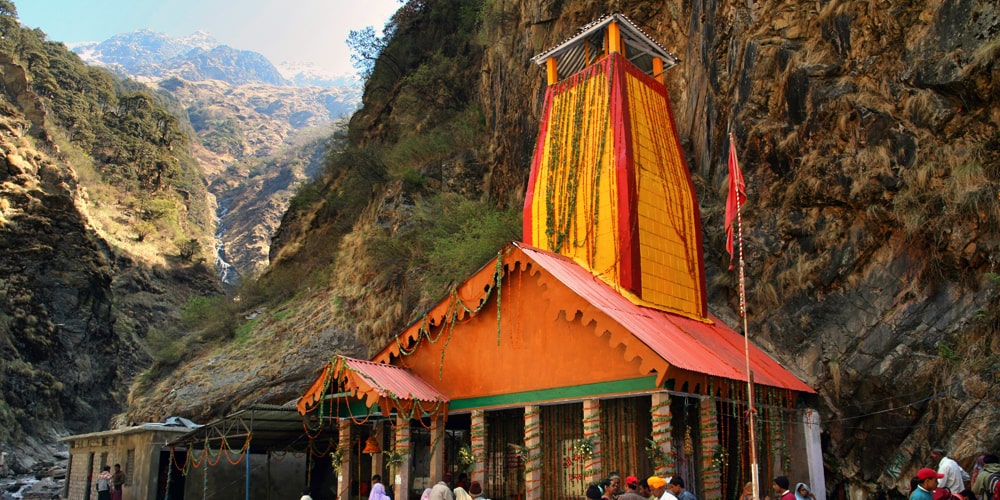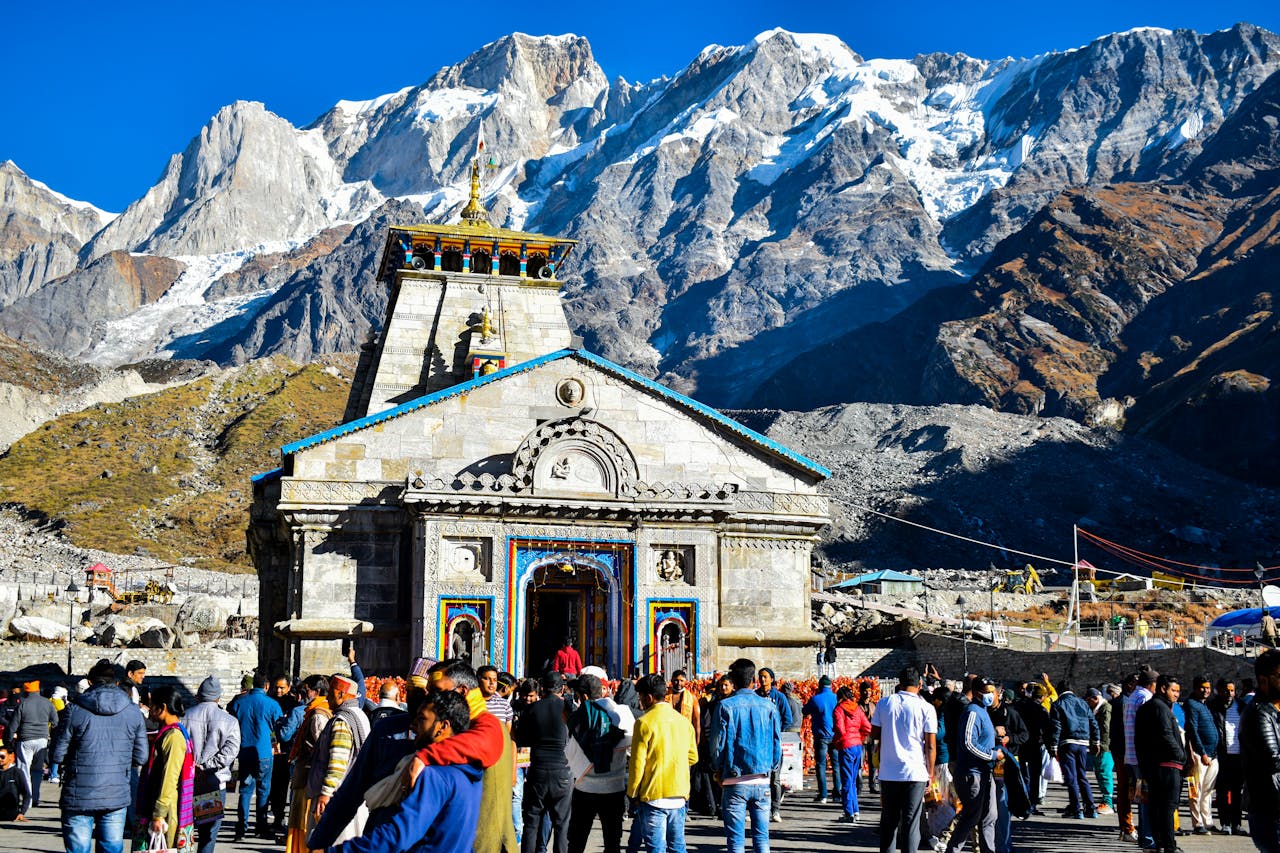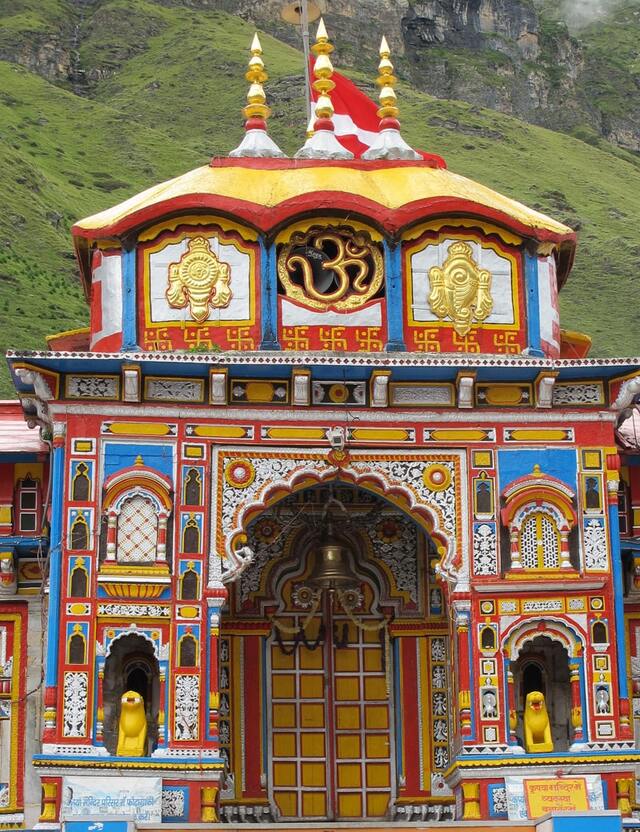Char Dham Yatra Packages
India's most spiritual Yatra!
4.7
(400+ reviews)
4.7
(100+ reviews)
4.7
(100+ reviews)
Uttarakhand Chardham Yatra
If you are a dedicated devotee of Vishnu-Mahesh, then the Chardham tour package hosted by Traveloi are for you. The sacred pilgrimage of Chardham is among the top spiritual journeys in India, extremely valued by Hindus and attracting religious travellers from all over the globe. It is often called as a soul-purifying experience, as the Chardham yatra package offers devotees an opportunity to witness the stunning mountain ranges of the Himalayas and attain deep inner peace, which is a great break from the daily routines. The Chardham tour package is a combination of four divine places- Yamunotri, Gangotri, Kedarnath, and Badrinath. All of these lie in the sublime Garhwal region of Uttarakhand, which is also known as the Devbhoomi or the Land of the Gods.
The Chardham tour package is not only a religious pilgrimage, but it is also a festival of faith, nature, and self-realization. At first, pilgrims reach Yamunotri, the origin of the sacred Yamuna River. Here, the temple provides blessings and the rejuvenating experience of a soak in the thermal springs. After that, the Gangotri temple is the next stop for the pilgrims. This temple is at the source of the Ganga River, a natural watercourse that is highly revered throughout India because of its historic origin and purity. Both the temples of Yamunotri and Gangotri welcome the worshippers on Akshaya Tritiya, a day that is considered auspicious according to the Hindu calendar.
Then the Chardham yatra package takes you to the holy Kedarnath temple, which is dedicated to Lord Shiva. Although the road leading to Kedarnath is quite difficult, it is also very beautiful. This is because it runs along the mountains covered with snow and through the green valleys. This is the place every Chardham tourist visits. The temple tentatively remains open from May 2nd till the end of October, and the exact dates vary every year according to the weather and snow conditions. Badrinath, the last stop of the pilgrimage, is a place dedicated to Lord Vishnu. It is famous not only for its lovely temple architecture, but also for the mountain view extending all around it. Thus, the final stage of the journey, Badrinath, is where those on pilgrimage can experience peace and spiritual enlightenment.
Travellers who purchase a Chardham yatra package will enjoy untroubled logistics, knowledgeable guides, and pre-arranged stays. These amenities give travellers freedom to immerse themselves in the spiritual and natural wonders of the area. The four Dhams opening and closing dates for 2025 depend on the weather and are thus very precisely handled: Yamunotri and Gangotri (30 April to 20 October, tentative), Kedarnath (2 May to 20 October), and Badrinath (4 May to 3 November).
To almost all people, the Chardham tour is a single opportunity that may not present itself again, to bond with India’s time-honored customs, to experience the unearthly beauty of the Himalayas, and to grasp the innermost side of faith. Whether one is on a spiritual quest or only intends to visit the marvels of nature in Uttarakhand, both the categories of pilgrims and tourists will agree that the Chardham yatra package has been an experience to treasure forever. Say Ohm Naman Shivay and get going on this spiritual awakening with us.
Chardham Places

Yamunotri

Gangotri

Kedarnath

Badrinath
Char Dham Opening and Closing Dates for 2026
The Char Dham doesn’t remain open throughout the year. The Yamunotri and Gangotri Dhams open on Akshaya Tritiya. The deities of all the four Dhams are moved to other places during the harsh winter months, when all the four Dham sites are covered in snow. Here are the details of the opening and closing dates of the Char Dham sites in 2026
| Chardham Temples | Opening Date | Closing Date |
| Yamunotri Temple | 19 April 2026 | 11 November 2026 [Tentative] |
| Gangotri Temple | 19 April 2026 | 11 November 2026 [Tentative] |
| Kedarnath Temple | 22 April 2026 | 11 November 2026 [Tentative] |
| Badrinath Temple | 24 April 2026 | 13 November 2026 [Tentative] |
Chardham Packages
More Info about Chardham Yatra
This question often comes up when people embark on this arduous journey. The four sacred sites located in the picturesque mountains of Uttarakhand are of huge significance to Hindus. Every year, lakhs of pilgrims visit these shrines in search of salvation. Here’s a quick look at the four sites:
Yamunotri:
Located at a height of 3,293 metres, the shrine at Yamunotri is dedicated to Goddess Yamuna, the daughter of Surya, the Sun God. An offering at this temple, accompanied by a holy dip in the Yamuna River, is believed to rid pilgrims of their sins. Pilgrims also seek the blessings of the Sun God here.
Gangotri:
Located on the banks of the Bhagirathi, which is considered the origin of the holy river Ganga, Gangotri is one of the most sacred sites in India. Hindu mythology states Ganga, known as a mother goddess, emerged here when Lord Shiva released her from his locks (“jataa”).
Kedarnath:
A little over 200 kilometres away from Rishikesh and near the Mandakini River, Kedarnath is a holy site in Rudraprayag, Uttarakhand. The Kedarnath Temple is made entirely of grey stone slabs, and Lord Shiva appears here in his Sadashiva avatar.
Badrinath:
Dedicated to Lord Badrinarayan (Vishnu), the Badrinath Temple is situated near the Alaknanda River. While Adi Shankaracharya first enshrined the black stone idol of Badrinarayan, the present temple was built by the King of Garhwal later.
Yamunotri
- Surya Kund : This thermal spring located in Yamunotri is named after Surya Dev, or the Sun God, who is also the father of Goddess Yamuna. Devotees often dip potatoes mixed with rice and salt, tied in a muslin cloth, in the Surya Kund and boil it to offer it to the deity.
- Saptarishi Kund : A glacial lake located at an altitude of 4.421 metres, the Saptarshi Kund has its source in the Champasar Glacier. About 7 kilometres from Yamunotri, this place can be reached by a difficult trek.
- Divya Shila : Divya Shila, or The Slab of the Divine Light, is a holy stone located outside the Yamunotri Temple. Most devotees worship the Shila before entering the Yamunotri Temple.
- The Shani Dev Temple : Known as the oldest temple dedicated to Shani Dev (the God of Justice), this temple is where Goddess Yamuna resides in the winter months. The four-storey temple that resembles a fort and is made of stone is also an architectural marvel.
Gangotri
- Pandava Gufa : Around 1.5 kilometres away from Gangotri, the Pandava Gufa is a natural cave formation. The trek to this place is through a lush landscape. This is believed to be the place where the Pandavas meditated on their way to Kailash.
- Tapovan : The arduous Tapovan trek starts from Gangotri and leads trekkers to the base of Mt. Shivling in the Himalayas. Located at an altitude of 4,500 metres, this place offers jaw-dropping views of the snow-capped peaks surrounding the area.
- Bhairon Ghati : Located near the confluence of the Bhagirathi and Jadh Ganga, this place also has a temple surrounded by lush greenery. Around 9 kilometres away from Gangotri, Bhairon Ghati can be reached through a difficult trek but offers stunning views.
- Kedartal : This glacial lake, located at an altitude of 4,750 metres, can be reached by a difficult trek from Gangotri. The tranquility of the lake, coupled by the beauty of its emerald-blue waters, makes this trek so special.
Kedarnath
- Gaurikund : Located at an altitude of 1,982 metres, Gaurikund is a spiritual destination on the way to Kedarnath. Famous for the Gauri Devi Temple, this place is named after Goddess Parvati, also known as Gauri.
- Adi Shankaracharya Samadhi : Known as an acharya of the Advaita Vedanta philosophy, Adi Shankaracharya attained moksha in Kedarnath. His samadhi (sacred resting place) is located right behind the Kedarnath Temple.
- Chorabari Tal : Also known as Gandhi Sarovar, this is a glacial lake located around 4 kilometres away from Kedarnath. Nestled at an altitude of 3,900 metres, this lake offers picturesque views of the stunning landscape surrounding the area. There is a waterfall on the way too.
- Vasuki Tal : Legend has it that Lord Vishnu took a holy bath in this lake on Raksha Bandhan. An arduous trek through lush meadows and overwhelming rocky paths leads tourists to this lake. While most trekkers begin this trek in Gaurikund, less experienced trekkers can take a pony ride to Kedarnath and proceed towards Vasuki Tal.
- The Bhairav Temple : Dedicated to Lord Bhairav, an avatar of Lord Shiva, the protector of Kedar Valley, this temple is a must-visit for all pilgrims. Located about 500 metres away from the Kedarnath Temple, this temple offers a scenic view of the surrounding landscape.
Badrinath
- Brahma Kapal : Located just 5 minutes away from the Badrinath Temple, this place is known for its spiritual significance. Apparently, when devotees pay homage to the departed souls of their ancestors here, they help them attain salvation from the karmic cycle.
- Tapt Kund : A natural hot spring located near the Badrinath Temple, Tapt Kund has its source in Garur Shila and the water here apparently has medicinal properties. The temperature of the spring can go up to 45 degrees.
- Charan Paduka : Located about 3 kilometres from the Badrinath Temple, Charan Paduka is a rock that is considered holy. It apparently contains the footprints of Lord Vishnu.
- Ganesha Cave : Nestled in Mana Village, this cave is around 3 kilometres away from the Badrinath Temple. Hindu mythology states that this is where Lord Ganesha wrote the Indian epic Mahabharata, as dictated by ancient sage Veda Vyasa.
- The Mata Murti Mandir : This temple, located around 3 kilometres away from the Badrinath Temple is dedicated to Mata Murti, the mother of Lord Bardrinarayan. Every year, the temple witnesses a fair on Shravan Dwadashi.
- Mana Village :Touted as “The Last Indian Village”, Mana is a quaint village on the Indo-Tibetan border, just 3 kilometres away from Badrinath. The village offers scenic views of the Saraswati River. Tourists can walk along the pretty cottages, chat with the locals and visit the Vasundhara Falls.
Tab 2 content.

The Dos and Don’ts: Important Information for Pilgrims
Like every travel destination, the Char Dham sites too have some dos and don’ts. Here’s a list of things you should keep in mind before embarking on your journey to the four sacred sites:
- You may need to remove your shoes before entering the temples.
- Wear modest, comfortable clothes in layers. Carry stoles to cover your heads before entering the temples.
- Carry toiletries and other essentials (moisturiser, sunscreen, torch, etc.).
- Try carrying a backpack and avoid carrying unnecessary luggage.
- Carry a medical kit with essentials such as painkillers, antibiotics, medicine for altitude sickness, paracetamol, antiseptic creams, cough drops, etc. (along with any personal prescribed medicines).
- The weather in the mountains is unpredictable. So, please carry a rain jacket, all-weather trek shoes, gloves, mufflers, umbrellas, woollen socks, woollen inners, sweaters, etc.
- Avoid clicking photos in sensitive areas or in holy places where photography is prohibited.
- Carry dry food items, such as chocolate, chips, cake, biscuits and dry fruits, along with glucose supplements and ORS.
- Make sure you carry enough cash to last the entire trip, as ATMs are not easily available in the remote areas that the trip covers.
- Alcohol and non-vegetarian food are not allowed at the holy sites. So, don’t carry any such items with you.
- Be prepared for sudden changes in the itineraries, due to weather changes, natural disasters or political unrest.
FAQs about Chardham
It is widely believed that the Char Dham sites of Kedarnath, Badrinath, Yamunotri and Gangotri are sacred for all Hindus. A journey to the Char Dham sites helps devotees gain moksha, or salvation.
The Char Dham yatra usually opens by the end of April or the beginning of May. It remains open till the end of October. During the winter months, the Char Dham shrines remain closed to the public and the deities are shifted to their winter abodes.
One of the 12 Jyotirlingas in India, the Kedarnath Temple is dedicated to Lord Shiva. The trek to the temple begins at Sonprayag or Sitapur and covers around 21 km. Named after King Kedar (a Satya Yuga king), this place is where Lord Shiva forgave the Pandavas and absolved them of their sins of killing their cousins (the Kauravas). While it is believed that the previous temple was built by the Pandavas, the present temple was constructed by 8th century Indian philosopher Adi Shankaracharya.
Apart from the Kedarnath temple, which is an awe-inspiring marvel, some of the other attractions near Kedarnath are Gaurikund, Adi Shankaracharya Samadhi, Chorabari Tal (a glacial lake) and the Bhairav Temple.
Badrinath is said to be a place where Nara Narayan Rishi (an avatar of Lord Vishnu) performed his “tapasya” to purify the world. He apparently sat beneath a large berry (“badri” in Sanskrit) tree that protected him from the sun and the rain. Some believe that Goddess Lakshmi had transformed into the berry tree to protect Nara Narayan.
Some of the major attractions in Badrinath, apart from the Badrinath Temple, are Brahma Kapal, Tapt Kund (a natural hot spring) and the Mata Murti Mandir.
Gangotri is considered to be the origin of the Holy Ganga (Ganges), a river that is sacred to Hindus. Gaumukh, a glacier about 19 km away from the Gangotri Temple is the source of the Ganga.
Apart from the Gangotri Temple, one can explore other major attractions in the vicinity, such as Pandava Gufa, Gauri Kund, Tapovan, Bhairon Ghati and Kedartal.
Yamunotri Dham is the abode of Goddess Yamuna, the sister of Lord Yama (the God of Death) and the daughter of Surya (the Sun God). The deity in the Yamunotri Temple is made of black marble. The temple was built by the Tehri king Maharaja Pratap Shah. After it was destroyed by a natural disaster, the temple was rebuilt by 19th century queen Maharani Gularia of Jaipur.
The main attraction of Yamunotri is the Yamuna Temple. Apart from this, you can explore the hot water springs of Janki Chatti or take a holy dip in the Yamuna River. Other attractions include Surya Kund, Saptarishi Kund and Divya Shila (the slab of the divine light).
During winter, the Char Dham sites face heavy snowfall and extreme weather conditions. The deities of the sites, namely, Kedarnath, Badrinath, Yamunotri and Gangotri, are moved to Ukhimath, Joshimath, Kharsali and Mukhba, respectively.
While all the four Char Dham sites are equally accessible to pilgrims and tourists, it is believed that the journey is spiritually effective if one completes it in a clockwise direction. So, the pilgrimage should ideally begin in Yamunotri and move towards Gangotri, followed by Kedarnath and eventually Badrinath.
The Char Dham sites are located at high altitudes and the journey may be strenuous for people with existing health conditions. The Uttarakhand government has issued a health advisory stating that pilgrims willing to undertake this journey can consider going through a health checkup to ensure they are fit to complete the pilgrimage. Cardiovascular exercises, regular walking, and “pranayama” are recommended too.
The Jolly Grant Airport in Dehradun is the most accessible for your Char Dham journey. Chartered flights to the Char Dham are available from Dehradun.
Pilgrims can reach Haridwar, Rishikesh, Delhi or Dehradun by train from any part of India. These places are well-connected by rail to all major cities of India. For the rest of the journey, one can easily get a bus or a cab to the Char Dham sites.
While all the four Char Dham sites are equally accessible to pilgrims and tourists, it is believed that the journey is spiritually effective if one completes it in a clockwise direction. So, the pilgrimage should ideally begin in Yamunotri and move towards Gangotri, followed by Kedarnath and eventually Badrinath.